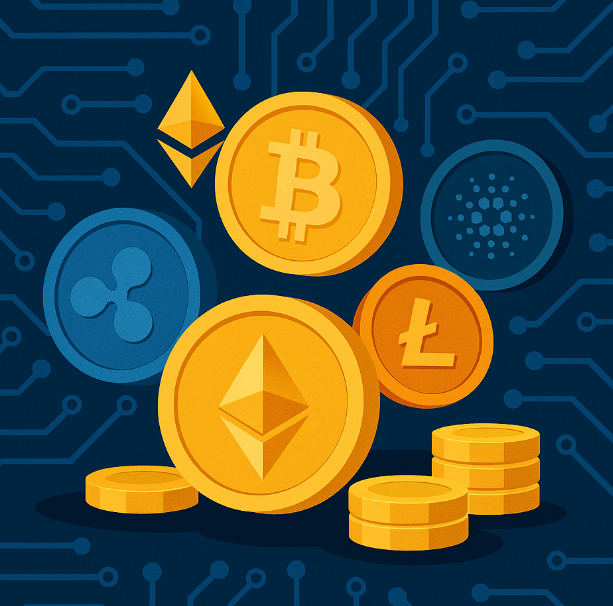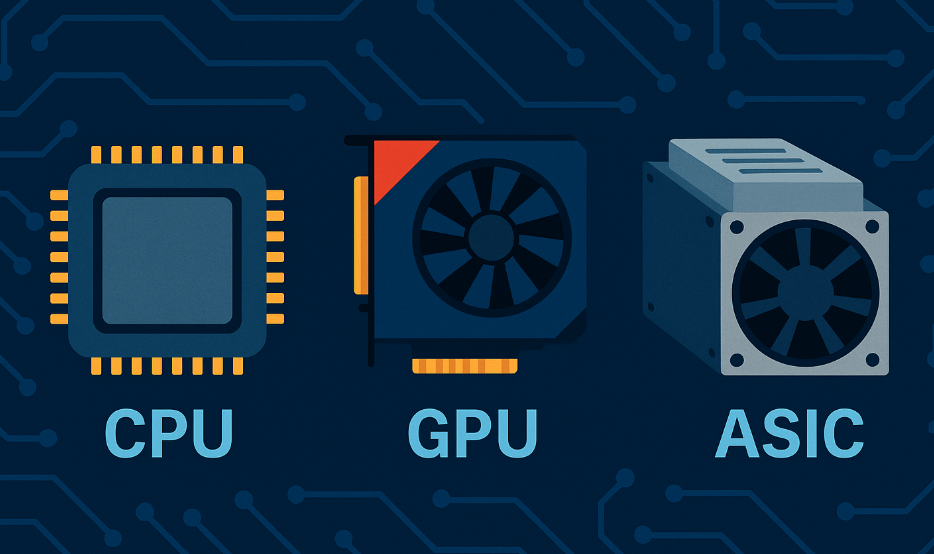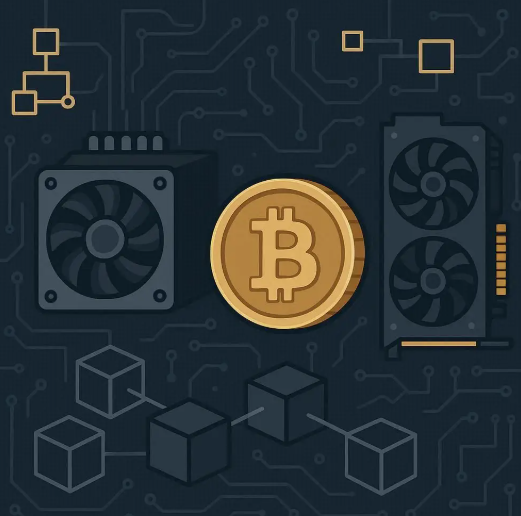Main > Blog > , You are here
The world of cryptocurrency is full of unique terms, and one of the most fundamental is mining. for many newcomers, this word is associated with something complex, accessible only to programmers and engineers. However, in reality, anyone can understand the essence of this process. Mining is not just a way to "print" digital money out of thin air; it is the foundation of the security and vitality of many cryptocurrencies, including Bitcoin.
In this article, we will explain in a detailed and accessible way what cryptocurrency mining is, how it works, what mining equipment is required, and how anyone can get involved in this process. We will go from theory to practice so you can understand how mining works and what opportunities it opens up.
What is Mining in Simple Terms?
To put it as simply as possible, cryptocurrency mining is the process of verifying and adding new transactions to the blockchain, for which participants receive a reward. Imagine a huge global ledger (the blockchain) where absolutely all transfers are recorded. To avoid fraud and errors, someone must check each entry, group them into "blocks," and add them to the overall chain.
These "accountants" are the miners. They use the power of their computers to solve complex mathematical problems. The first one to solve the problem gets the right to "seal" a new block with transactions and add it to the blockchain. For this work, the system rewards them with a certain amount of new coins (e.g., bitcoins) and the transaction fees included in the block.
So, what is mining? It is simultaneously:
Transaction Confirmation: Miners guarantee that all transfers on the network are legitimate.
Providing Security: Thanks to the work of miners, the blockchain becomes immutable and protected from attacks.
Issuance of New Coins: This is the only way new units of many cryptocurrencies are created.
Thus, miners are not just coin extractors, but the foundation on which the entire blockchain rests, as they are simultaneously the guardians of security, the validators of transactions, and the mechanism for fair issuance. It is their continuous work that ensures the value and reliability of cryptocurrencies.

How Mining Happens: A Look Under the Hood
Now let's delve into the technical details of how mining happens. The process is based on the Proof-of-Work consensus algorithm.
Block Formation: Miners collect all new, unconfirmed transactions from the network (the mempool) into a candidate block.
Searching for the "Hash": The main task of a miner is to find the correct "hash" for their block. A hash is a unique digital fingerprint of a fixed length. The miner must find a special number (a nonce) to add to the block so that the hash of the entire block meets certain difficulty criteria (e.g., starts with a certain number of zeros).
"Brute-Forcing": This search is done by simply trying billions of combinations per second. This is why enormous computational power is needed. It's like trying to guess the code for a lock with trillions of possible combinations.
Solution Found: The first miner or mining pool that finds the correct hash broadcasts their block to the network.
Verification and Confirmation: Other participants in the network (nodes) quickly verify if the found hash is correct. This verification, unlike the search, is very simple and does not require much power. If everything is correct, the node adds the new block to its copy of the blockchain.
The Reward: The miner who found the solution receives the block reward. For example, on the Bitcoin network, the reward consists of new BTC and all transaction fees in that block.
This continuous process of competing for the right to add a block ensures the operation and security of the network.
The Evolution of Hardware: From CPU to ASIC
At the dawn of cryptocurrencies, mining was like prospecting for gold in unsettled lands—simple enthusiasm and a regular home computer were enough. However, like in any gold rush, as popularity and competition grew, a real technological arms race began. Network difficulty grew, and to maintain profitability, miners needed ever more powerful and efficient tools. This journey turned ordinary PCs into specialized machines and laid the foundation for an entire industry. Let's trace this fascinating evolutionary path: from humble central processing units (CPUs) to ultra-efficient ASIC devices.
CPU Mining
In the early days of cryptocurrencies, when Bitcoin mining was just beginning, the power of a regular home computer was sufficient. Satoshi Nakamoto mined the first blocks on a CPU. However, the network's difficulty grew quickly, and processors could no longer keep up.
GPU Mining
The next step was mining on graphics cards (GPUs). Graphics processing units were originally designed to process graphics and can perform thousands of similar parallel computations, which is ideal for hash brute-forcing. Mining cryptocurrency on a video card became a real revolution and remains relevant for many altcoins.
ASIC Mining
The pinnacle of evolution was ASIC mining. An ASIC (Application-Specific Integrated Circuit) is an integrated circuit created to perform a single, specific task. ASIC miners are tailored for a specific hashing algorithm (e.g., SHA-256 for Bitcoin) and outperform GPUs hundreds of times over in efficiency and power consumption. Today, Bitcoin and Litecoin mining are profitable exclusively on ASIC devices.

What is a Mining Farm and How Does It Work?
When the power of a single device is not enough, enthusiasts build entire complexes. A mining farm is essentially a computer assembled from several high-performance devices (most often video cards or ASIC miners) working together to mine cryptocurrency.
What you need for a GPU mining farm:
Frame (Rig): A special open-air case for mounting all components.
Motherboard: With a large number of PCI-Express slots to connect the video cards.
CPU and RAM: Powerful models are not required for a farm; the most basic ones will suffice.
Video Cards (GPUs): The main component, which determines the hash rate (computational power).
Power Supply Units (PSUs): One or more powerful units capable of powering all the video cards.
Cooling System: Powerful fans or other solutions to dissipate the enormous amount of heat.
How does a mining farm work? It's simple: all the video cards or ASIC devices are connected to one system, on which special software is installed. This program (mining software) makes all the devices work on a single task—searching for a hash—by combining their computational power. Such a setup significantly increases the chances of finding a block and receiving a reward.
Methods of Mining: Solo, Pool, or Cloud
Let's imagine you are a gold prospector with a brand new pickaxe (your hardware). Now you face a strategic choice: do you go searching alone, hoping to find a huge nugget and take all the gold for yourself? Or do you join a large team where everyone works together and shares the findings, ensuring a stable, albeit small, income? Or perhaps you'd rather not get your hands dirty at all and just rent a share in an already operating mine? In the world of crypto mining, the same three main strategies exist: solo mining, teamwork (a mining pool), and renting power (cloud mining). The choice of one of these paths directly affects your potential profit, risks, and level of involvement in the process.
Solo Mining
Solo mining is mining cryptocurrency on your own. You direct all the power of your equipment to solving blocks by yourself. If you manage to find a block, you get to keep the entire reward. However, in popular networks (like Bitcoin), the difficulty is so high that you could mine for years and not find a single block. This method is only suitable for very large industrial farms or for mining new, unpopular coins with low difficulty.
Mining Pool
A mining pool is a server that combines the computational power of thousands of miners from around the world. Pool participants work together to find a single block. When one of the participants finds a solution, the block reward is distributed among everyone proportionally to their contribution (their hash rate). This makes the income stable and predictable, though small. It is this stable income that most miners immediately use for a cryptocurrency exchange to lock in profits or invest in other assets, making participation in a pool the only profitable option for most.
Cloud Mining
Cloud mining is the rental of computational power from large data centers. You buy a contract for a certain hash rate for a specific period and receive income without having to buy and set up your own equipment. This is an excellent option for those who want to try online mining without investing in "hardware." The pros are obvious: no noise, no heat, and no electricity bills. However, this market is full of fraudulent schemes, so choosing a provider must be done with extreme caution.

Mining Platforms: PC, Laptop, Phone
Choosing a platform is one of the first and most important steps for a beginner miner. Can you use your home computer, is it worth risking your laptop, or is there any point in phone apps? Let's take a detailed look at the possibilities and pitfalls of each of these approaches, because the right choice affects not only your potential profit but also the longevity of your hardware.
PC Mining and Home Mining
The most common method for beginners is mining on a PC, especially if you have a powerful gaming video card. Mining at home is quite realistic, but you need to be prepared for constant fan noise, increased heat output, and, most importantly, significantly higher electricity bills.
Laptop Mining
Technically, mining on a laptop is possible, but it is strongly discouraged. Laptop cooling systems are not designed for 24/7 100% load, which will quickly lead to overheating and failure of expensive components.
Phone Mining
Mining on a phone in its classic sense (Proof-of-Work) is a myth. A smartphone's power is absolutely insufficient to compete on any serious network. Apps that promise cryptocurrency mining on your phone are most often either simulators or disguised wallets for other purposes. The only realistic scenario is cloud mining on a phone, where the smartphone is used merely as an interface to manage your contract on a remote server.
Mining Different Cryptocurrencies: From Giants to Altcoins
Not all coins can be mined, and different coins require different approaches.
Ethereum Mining: It's important to know that after Ethereum's transition to the Proof-of-Stake algorithm (The Merge) in 2022, classic mining of Ether on video cards became impossible.
Dogecoin Mining: The mining of this popular meme coin often occurs in conjunction with Litecoin mining, as they use a similar Scrypt algorithm.
Altcoin Mining: There are many coins that are still profitable to mine on GPUs. Among them are Ravencoin mining (KawPoW algorithm) and Vertcoin mining (Verthash), which were specifically designed to be ASIC-resistant.
Helium Mining: This is a completely different type of "mining," based on the Proof-of-Coverage algorithm. Network participants buy special devices (hotspots) that provide coverage for the LoRaWAN wireless network and receive rewards in HNT coins for doing so.
As you can see, the mining ecosystem is incredibly diverse: from coins requiring specialized ASIC devices to projects with unique mechanics like Helium. Therefore, before you start, it is crucial to do your own research (DYOR) and choose a coin that matches your equipment and goals. However, it is just as important to know about those assets that cannot be mined at all, so as not to fall victim to misconceptions.
Myths About Mining: Can You Mine XRP and USDT?
Newcomers often ask about mining popular assets. It's important to clarify this here.
XRP Mining: The definitive answer is no. XRP mining is impossible. All 100 billion XRP coins were pre-mined by the company Ripple at the outset. The network operates on its own consensus algorithm, which does not involve mining. Searches like "XRP mining" arise from a misunderstanding of the technology.
USDT Mining: Similarly, USDT mining is impossible. USDT (Tether) is a stablecoin, centrally issued by the company Tether Limited and backed by real assets. New tokens are created by the company in response to market demand, not extracted by miners. Some cloud mining services may pay out rewards in USDT, which gives rise to this erroneous term.
More Than Just "Printing Money"
Cryptocurrency mining is a complex but fascinating process that is the cornerstone of the decentralized economy. It has come a long way from a hobby for enthusiasts to a multi-billion dollar industry. For a beginner today, the barrier to entry may seem high due to the cost of equipment and electricity. However, options like pools and cloud mining make it accessible to a wider range of people. The main thing is to approach this process wisely, carefully calculate profitability, and remember the risks.
